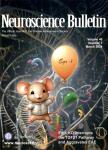The Periaqueductal Gray and Its Extended Participation in Drug Addiction Phenomena
作者机构:Departamento de Fisiologia y FarmacologiaCentro de Ciencias BasicasUniversidad Autonoma de AguascalientesCiudad Universitaria20131 AguascalientesAgs.Mexico Departamento de FisiologiaEscuela Nacional de Ciencias BiologicasInstituto Politecnico NacionalWilfrido Massieu esq.Manuel Stampa s/n Col.Nueva Industrial Vallejo07738 Gustavo A.MaderoMexico CityMexico
出 版 物:《Neuroscience Bulletin》 (神经科学通报(英文版))
年 卷 期:2021年第37卷第10期
页 面:1493-1509页
核心收录:
学科分类:0710[理学-生物学] 1002[医学-临床医学] 07[理学] 1001[医学-基础医学(可授医学、理学学位)] 071006[理学-神经生物学] 100204[医学-神经病学] 10[医学]
基 金:by the Direccion General de Investigacion y Posgrado from the Autonomous University of Aguascalientes.PB-I was supported by the PRODEP program and an early career research grant from the International Association for the Study of Pain.AM-P was supported by the“Instituto Polit6cnico Nacional”(SIP-IPN 20200241) PV-L was supported by a CONACyT Postdoctoral Fellowship(406562) Figure 1 was partially drawn using biorender.com.BAM-C,PB-I,PV-L and JC-R are current fellows of the**Sistema Nacional de Investi-gadores”from CONACYT.
主 题:Periaqueductal gray Reward circuit Antireward circuit Alcohol Caffeine Cannabis Opioids Stimulants
摘 要:The periaqueductal gray(PAG)is a complex mesencephalic structure involved in the integration and execution of active and passive self-protective behaviors against imminent threats,such as immobility or flight from a predator.PAG activity is also associated with the integration of responses against physical discomfort(e.g.,anxiety,fear,pain,and disgust)which occurs prior an imminent attack,but also during withdrawal from drugs such as morphine and cocaine.The PAG sends and receives projections to and from other well-documented nuclei linked to the phenomenon of drug addiction including:(i)the ventral tegmental area;(ii)extended amygdala;(iii)medial prefrontal cortex;(iv)pontine nucleus;(v)bed nucleus of the stria terminalis;and(vi)hypothalamus.Preclinical models have suggested that the PAG contributes to the modulation of anxiety,fear,and nociception(all of which may produce physical discomfort)linked with chronic exposure to drugs of abuse.Withdrawal produced by the major pharmacological classes of drugs of abuse is mediated through actions that include participation of the PAG.In support of this,there is evidence of functional,pharmacological,molecular.And/or genetic alterations in the PAG during the impulsive/compulsive intake or withdrawal from a drug.Due to its small size,it is difficult to assess the anatomical participation of the PAG when using classical neuroimaging techniques,so its phys-iopathology in drug addiction has been underestimated and poorly documented.In this theoretical review,we discuss the involvement of the PAG in drug addiction mainly via its role as an integrator of responses to the physical discomfort associated with drug withdrawal.



